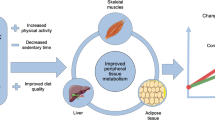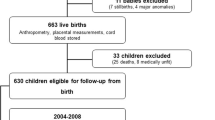Abstract
The effect of increased recreational physical activity in children on insulin levels has not yet been studied. We carried out a randomized controlled trial in 76 children 6–9 years old, 32 of them increased their physical activity and 30 maintained the same level. In the intervention group, after a week of baseline, recreational activity three times/week was programmed for 12 weeks. We compared insulin, homeostatic model assessment (HOMA) index, glucose, HDL-C, LDL-C, triglycerides, and body mass index in both groups. Thereafter, we compared groups of normal weight, overweight, and with obesity in the experimental group. The group of recreational activity increased their median daily steps (15,329 to 19,910) and decreased insulin (p < 0.001) and HOMA index (4.36 vs. 2.39, p < 0.001). The diminution of insulin levels was more significant in the overweight group (p < 0.007). In conclusion, in our group, children who increased physical activity during 12 weeks decrease insulin levels and insulin resistance without change in other metabolic and anthropometric variables.



Similar content being viewed by others
References
Ainslie PN, Reilly T, Westerterp KR (2003) Estimating human energy expediture: a review of techniques with particular reference to dobly labelled water. Sports Med 33:683–698, doi:10.2165/00007256-200333090-00004
Al-Hazzaa MH (2007) Pedometer-determined physical activity among obese and non-obese 8- to 12-year-old Saudi schoolboys. J Physiol Anthropol 26:459–465, doi:10.2114/jpa2.26.459
Ara I, Vicente-Rodriguez G, Perez-Gomez J et al (2006) Influence of extracurricular sport activities on body composition and physical fitness in boys: a 3-year longitudinal study. Int J Obes 30:1062–1071, doi:10.1038/sj.ijo.0803303
Aradillas-Garcia C, Malacara JM, Garay-Sevilla ME et al (2007) Prediabetes in rural and urban children in 3 states in Mexico. JCMS 2:35–39
Atabek ME, Pirgon O (2007) Assessment of insulin sensitivity from measurements in fasting state and during an oral glucose tolerance test in obese children. J Pediatr Endocrinol Metab 20:187–195
Balady GJ, Berra KA, Golding LA et al (2000) ACSM’s guidelines for exercise testing and prescription. Lippincont Williams & Wilkins, Indianapolis
Bell LM, Watts K, Siafarikas A et al (2007) Exercise alone reduces insulin resistance in obese children independently of changes in body composition. J Clin Endocrinol Metab 92:4230–4235, doi:10.1210/jc.2007-0779
Brooks N, Layne JE, Gordon PL (2006) Strength training improves muscle quality and insulin sensitivity in Hispanic older adults with type 2 diabetes. Int J Med Sci 4:19–27
Caballero AE (2007) Type 2 diabetes in the Hispanic or Latino population: challenges and opportunities. Curr Opin Endocrinol Diabetes Obes 14:151–157
Caballero AE, Bousquet-Santos K, Robles-Osorio L et al (2008) Overweight Latino children and adolescents have marked endothelial dysfunction and subclinical vascular inflammation in association with excess body fat and insulin resistance. Diabetes Care 31:576–582, doi:10.2337/dc07-1540
Cole TJ, Bellizzi MC, Flegal KM, Dietz WH (2000) Establishing a standard definition for child overweight and obesity worldwide: international survey. BMJ 320:1240–1243, doi:10.1136/bmj.320.7244.1240
Conwell LS, Trost SG, Spence L (2008) The feasibility of a home-based moderate-intensity physical activity intervention in obese children and adolescents. Br J Sports Med. doi:10.1136/bjsm.2008.046359
Council on Sports Medicine and Fitness and Council on School Health Active Healthy Living (2006) Prevention of childhood obesity through increased physical activity. Pediatrics 117:1834–1842, doi:10.1542/peds.2006-0472
Chen W, Srinivasan SF, Li S et al (2005) Metabolic syndrome variables at low levels in childhood are benefically associated with adulthood cardiovascular risk. Diabetes Care 28:126–131, doi:10.2337/diacare.28.1.126
Daniels SE, Greer FR, the Committee on Nutrition (2008) Lipid screening and cardiovascular health in childhood. Pediatrics 122:198–208, doi:10.1542/peds.2008-1349
Deforche B, De Bourdeaudhuij I, Debode P et al (2003) Changes in fat mass, fat-free mass and aerobic fitness in severely obese children and adolescents following a residential treatment programme. Eur J Pediatr 162:616–622, doi:10.1007/s00431-003-1247-2
Del Río-Navarro BE, Velásquez-Monroy O, Sánchez-Castillo CP et al (2004) The high prevalence of overweight and obesity in Mexican children. Obes Res 12:215–223, doi:10.1038/oby.2004.28
Duncan GE, Perri MG, Theriaque DW et al (2003) Exercise training, without weight loss, increase insulin sensibility and postheparin plasma lipase activity in previously sedentary adults. Diabetes Care 26:557–562, doi:10.2337/diacare.26.3.557
Ferguson MA, Gutin B, Le NA et al (1999) Effects of exercise training and its cessation on components of the insulin resistance syndrome in obese children. Int J Obes Relat Metab Disord 23:889–895, doi:10.1038/sj.ijo.0800968
Hancox RJ, Milne BJ, Poulton R (2004) Association between child and adolescent television viewing and adult health: a longitudinal birth cohort study. Lancet 364:257–262, doi:10.1016/S0140-6736(04)16675-0
Holten MK, Zacho M, Gaster M et al (2004) Strength training increases insulin-mediated glucose uptake, GLUT4 content and insulin signaling in skeletal muscle in patients with type 2 diabetes. Diabetes 53:294–305, doi:10.2337/diabetes.53.2.294
Janssen I, Katzmarzyk PT, Boyce WF, Health Behaviour in School-Aged Children Obesity Working Group et al (2005) Comparison of overweight and obesity prevalence in school-aged youth from 34 countries and their relationships with physical activity and dietary patterns. Obes Rev 6:123–132, doi:10.1111/j.1467-789X.2005.00176.x
Lee S, Kuk JL, Davidson LE et al (2005) Exercise without weight loss is an effective strategy for obesity reduction in obese individuals with and without type 2 diabetes. J Appl Physiol 99:1220–1225, doi:10.1152/japplphysiol.00053.2005
Lorenzo C, Williams K, Hunt KJ, Haffne SM (2006) Trend Preval Metab Syndr Its Impact Incidence Diabetes Care 29:625–630
Matthews DR, Hosker JP, Rudenski AS (1985) Homeostasis model assessment: insulin resistance and beta-cell function from fasting plasma glucose and insulin concentrations in man. Diabetologia 28:412–419, doi:10.1007/BF00280883
Maud PJ, Foster C (1995) Physiological assessment of human fitness. Human Kinetics, Philadelphia, USA
Monzavi R, Dreimane D, Geffner ME et al (2006) Improvement in risk factors for metabolic syndrome and insulin resistance in overweight youth who are treated with lifestyle intervention. Pediatrics 117:e1111–e1118, doi:10.1542/peds.2005-1532
Poehlman ET, Dvorak RV, De Nino WF et al (2000) Effects of resistance training and endurance training on insulin sensitivity in nonobese, young women: a controlled randomized trail. J Clin Endocrinol Metab 85:2463–2468, doi:10.1210/jc.85.7.2463
Prangrazi PR, Beighele A, Beige T, Vack C (2003) Impact of Promoting Lifestyle Activity for Youth (PLAY) on children’s physical activity. J Sch Health 73:317–321
Proctor MH, Moore LL, Gao D et al (2003) Television viewing and change in body fat from preschool to early adolescence: the Framingham Children’s Study. Int J Obes 27:827–833, doi:10.1038/sj.ijo.0802294
Redman LM, Heilbronn LK, Martin CK et al (2007) Effect of calorie restriction with or without exercise on body composition and fat distribution. J Clin Endocrinol Metab 92:865–872, doi:10.1210/jc.2006-2184
Rosenberg DE, Sallis JF, Conway TL et al (2006) Active transportation to school over 2 years in relation to weight status and physical activity. Obesity (Silver Spring) 14:1771–1776, doi:10.1038/oby.2006.204
Ross R, Janssen I, Dawson J et al (2004) Exercise-induced reduction in obesity and insulin resistance in women: a randomized controlled trial. Obes Res 12:789–798, doi:10.1038/oby.2004.95
Saris WH, Blair SN, van Baak MA et al (2003) How much physical activity is enough to prevent unhealthy weight gain? Outcome of the IASO 1st stock conference and consensus statement. Obes Rev 4:101–114, doi:10.1046/j.1467-789X.2003.00101.x
Shoelson SE, Lee J, Goldfine AB (2006) Inflammation and insulin resistance. J Clin Invest 116:1793–1801, doi:10.1172/JCI29069
Sothern MS, Loftin M, Suskind RM et al (1999) The health benefits of physical activity in children and adolescents: implications for chronic disease prevention. Eur J Pediatr 158:271–274, doi:10.1007/s004310051070
Sugiura H, Kajima K, Mirbod SM et al (2002) Effects of long-term moderate exercise and increase in number of daily steps on serum lipids in women: randomised controlled trial ISRCTN21921919. BMC Womens Health 2:3, doi:10.1186/1472-6874-2-3
Tapia-Ceballos L (2007) Metabolic syndrome in childhood. Ann Pediat (Barc) 66:159–166
Ten S, Maclaren N (2004) Insulin resistance syndrome in children. J Clin Endocrinol Metab 89:2526–2539, doi:10.1210/jc.2004-0276
Vaidya D, Szklo M, Liu K et al (2007) Defining the metabolic syndrome construct: multi-ethnic study of atherosclerosis (MESA) cross-sectional analysis. Diabetes Care 30:2086–2090, doi:10.2337/dc07-0147
Ziviani J, Scott J, Wadley D (2004) Walking to school: Incidental physical activity in the daily occupations of Australian children. Occup Ther Int 11:1–11, doi:10.1002/oti.193
Acknowledgment
This study was supported in part by grant number FOMIX GTO-2006-C01-31929.
Conflict of interest statement
The authors do not have financial interest with the organization that sponsored this work.
Author information
Authors and Affiliations
Corresponding author
Rights and permissions
About this article
Cite this article
Macias-Cervantes, M.H., Malacara, J.M., Garay-Sevilla, M.E. et al. Effect of recreational physical activity on insulin levels in Mexican/Hispanic children. Eur J Pediatr 168, 1195–1202 (2009). https://doi.org/10.1007/s00431-008-0907-7
Received:
Accepted:
Published:
Issue Date:
DOI: https://doi.org/10.1007/s00431-008-0907-7




